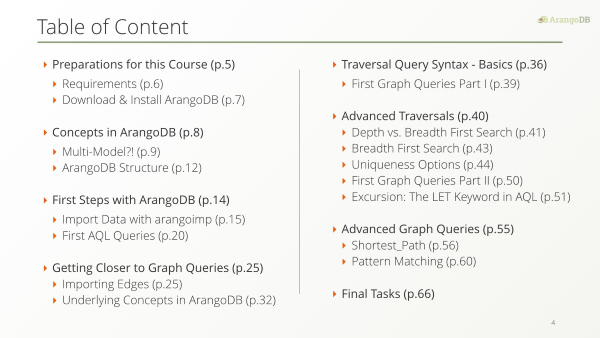AWS Neptune: A New Vertex in the Graph World — But Where’s the Edge?
At AWS Re:Invent just a few days ago, Andy Jassy, the CEO of AWS, unveiled their newest database product offerings: AWS Neptune. It’s a fully managed, graph database which is capable of storing RDF and property graphs. It allows developers access to data via SPARQL or java-based TinkerPop Gremlin. As versatile and as good as this may sound, one has to wonder if another graph database will solve a key problem in modern application development and give Amazon an edge over its competition. Read More
From Zero to Advanced Graph Query Knowledge with ArangoDB
Thinking about your data as a highly connected set of information is a powerful way to gain insights, solve problems and bring products faster into the hands of your users.
Unlike other databases, relationships take the first priority in graph databases and with ArangoDBs multi-model approach for graphs, documents and key/value pairs you can even switch between models or combine them in a single query.
The graph concept is booming but still new to many. So we invested a few bazillion coffees and some night shifts to come up with a good plan for a Graph Course:
How to model customer surveys in a graph database
Use-Case
The graph database use-case we are stepping through in this post is the following: In our web application we have several places where a user is led through a survey, where she decides on details for one of our products. Some of the options within the survey depend on previous decisions and some are independent.
Examples:
- Configure a new car
- Configure a new laptop
- Book extras with your flight (meal, reserve seat etc.)
- Configure a new complete kitchen
- Collect customer feedback via logic-jump surveys
Index Free Adjacency or Hybrid Indexes for Graph Databases
Some graph database vendors propagandize index-free adjacency for the implementation of graph models. There has been some discussion on Wikipedia about what makes a database a graph database. These vendors tried to push the definition of index-free adjacency as foundation of graph databases, but were stopped by the community.
Read more
Data Modeling with Multi-Model Databases: ArangoDB Insights
Max published an article on O’Reilly Radar about the use case he presented on Strata+Hadoop World in London earlier this year.
Read how multi-model databases can be used in an aircraft fleet maintenance system by mixing different data models within the same data store. 
A query language like AQL can help to answer maintenance questions like:
- What are all the parts in a given component?
- Given a (broken) part, what is the smallest component of the aircraft that contains the part and for which there is a maintenance procedure?
- Which parts of this aircraft need maintenance next week?
Read on: O’Reilly Radar – Data modeling with multi-model databases
Graphs in data modeling
Max wrote an inspiring article about graphs in data modeling on Medium, packed with his own thoughts – “to sort out some things in my brain” (Max).
He asks and answers the question: Are graphs and graph databases useful in data modeling, and if so, for what and under which circumstances?
In his article, he goes all the way down from the theoretical approach of what is a graph? towards storing a graph in different storage models (RDBMS, document store and graph databases) to querying a graph and finally to his personal conclusion. (more…)
ArangoDB Java Driver for Graphs: Enhanced Functionality
After defining a graph and filling it with some vertices and edges (see part 1), the time has come to retrieve information out of the graph.
Please take a look at the defined graph operations of ArangoDB. These will be the base for our next examples. (Yes, there may be other ways to get the results, this post does not claim completeness!)
We will start with some easy stuff and then smoothly advance in complexity.
Question: “How many edges are defined within the graph?”
ArangoDB Java Driver: Graph Data Manipulation & Queries
With ArangoDB 2.2 the new graph API was released featuring multi collection graphs (see blog). With the new version (2.2.1) of arangodb-java-driver the new graph API is supported. In the following you can find a small example of creating a graph with Java.
For the import via maven and configuring the driver, please read the Basics and Driver Setup. For the following we assume, that arangodbDriver is a configured instance of the driver.
So let’s start the whole thing…
Data Modeling: MongoDB vs ArangoDB | ArangoDB Blog
MongoDB is a document DB whereas ArangoDB is a multi-model DB supporting documents, graphs and key/values within a single database. When it comes to data modeling and data querying, they pursue somewhat different approaches.
In a Nutshell: In MongoDB, data modeling is “aggregate-oriented”, avoiding relations and joins. On the other side, everybody has probably used relational databases which organize the data in tables with relations and try to avoid as much redundancy as possible. Both approaches have their pros and cons. ArangoDB is somewhat in-between: You can both model and query your data in a “relational way” but also in an “aggregate-oriented way”, depending on your use case. ArangoDB offers joins, nesting of sub-documents and multi-collection graphs. (more…)
- « Previous
- 1
- 2
- 3
Get the latest tutorials,
blog posts and news:
Thanks for subscribing! Please check your email for further instructions.

